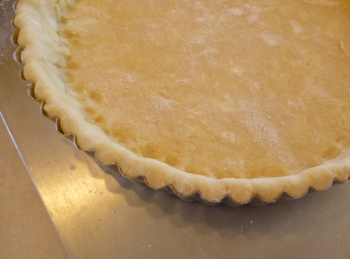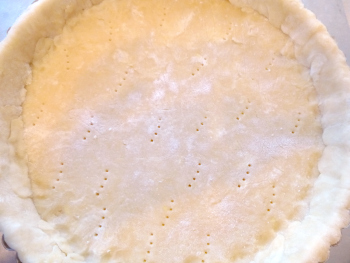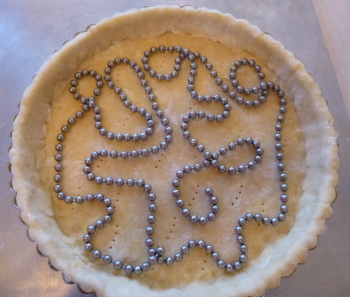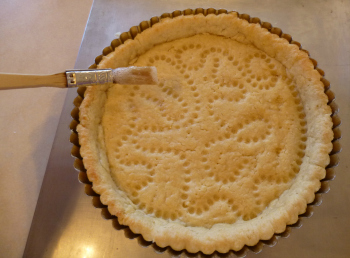Questions & Answers
Q: Do you prefer a particular type of pie plate?
A: Why, yes, I do! I much prefer a glass pie plate, like Pyrex.® The main reason is that you can see through the bottom, which is crucial for knowing when your pie is done. This is important because by being able to see that your bottom crust is a golden color, you are assured that it is cooked correctly and won’t be turning soggy on you later.
It also seems to me that the glass plates convey heat evenly, and I find them to be more appealing visually than metal ones. Decorative ceramic plates provide an attractive presentation, but they too have the drawback of not being able to judge the pie by its bottom. So to speak.
Your Pie Pal, Rebecca
Q: My tart shells are either too fragile or too soggy. Help!
A: Many tarts call for a pre-baked crust, so let’s start with that. To prevent a soggy bottom crust, preheat a cookie sheet in the oven and place your pastry on that to bake. Make sure to bake it long enough that the crust is golden in the center. If the edges are getting done sooner, cover them with a pie crust shield to prevent further darkening.
 As for the fragile crust issues, one way to deal with that is to roll the dough out so it will extend about ¾” beyond the rim of the tart pan. Trim it to that length, then fold the extra towards the inside, pinching it to fit against the side and inside bottom edge of the crust. See photo. This creates a little stronger outside edge, which is good.
As for the fragile crust issues, one way to deal with that is to roll the dough out so it will extend about ¾” beyond the rim of the tart pan. Trim it to that length, then fold the extra towards the inside, pinching it to fit against the side and inside bottom edge of the crust. See photo. This creates a little stronger outside edge, which is good.
Crusts tend to “poof up” during baking (which is actually a good sign, indicating flakiness). But, you don’t want the poofs to take up space where the filling will go, plus poofs would also make your finished tart shell more fragile. To prevent that, prick the pastry with a fork before baking it (ONLY if this is a pre-baked shell, not if you’re baking it together with the filling). See picture.
And, use pie weights! (See below.) The easiest solution is to use a pie weight chain, as shown here, because it can easily be removed after baking. The other option is to line the bottom of your unbaked, pricked tart shell with parchment paper and add weights (like uncooked beans). Remove the parchment and weights halfway through the baking so that the inside bottom can cook thoroughly. Early in the baking process (like after 5 minutes), you can check to see if the pastry is poofing up and gently poke any such places with a fork.

Finally, to prevent soggy bottom tart shells, two things. If pre-baking, when you take the tart shell out of the oven, wait 1-2 minutes then use a pastry brush and apply a little frothy egg white to the inside.  This will essentially cook the egg white from the heat of the pastry and will seal the crust. If the pastry is not pre-baked (and is only baked with the filling), then be sure to preheat a cookie sheet in the oven and place your tart on that to bake. This will ensure that the bottom gets enough heat to bake well, plus it will catch any drips and dribbles that might leak out of the tart!
This will essentially cook the egg white from the heat of the pastry and will seal the crust. If the pastry is not pre-baked (and is only baked with the filling), then be sure to preheat a cookie sheet in the oven and place your tart on that to bake. This will ensure that the bottom gets enough heat to bake well, plus it will catch any drips and dribbles that might leak out of the tart!
Yum, go for it.
Rebecca, Your Pie Pal
Q: What’s the difference between a pie and a tart?
A: The crust, primarily, then the shape. A tart crust is made with butter, usually has some sugar in it, and will be much more solid than a typical pie crust. Like pie, a tart crust will be chilled before being put into the tart pan, but will much more like a cookie dough in the way it handles – more likely to tear and need to be worked with the fingers to get it to fit into the pan. And the result is much more like a cookie – richer and more solid than pie pastry.
As for the shape, tarts are usually made in round pans with edges that stand straight up rather than being slanted like a pie pan. In fact, they’re usually made in metal tart pans where the outside ring lifts away after baking, revealing a crust that stands up straight and has a little “in and out” curve to it all the way around. Finished crusts are usually ¾ to 1 inch tall.
Tart fillings will be similar to pies, but less “juicy.” Cooked fruit fillings are more likely to be made from dried or preserved fruits rather than fresh ones. Other fillings often include nuts or chocolate. When a fresh fruit tart is made, a light custard is usually spread on the pre-baked crust, topped with colorful fresh fruit pieces, and glazed with a fruit jelly that has been melted and spread over the fruit to give it a shiny look.
Your Pie Pal, Rebecca
Q: What’s your favorite pie to make for yourself to enjoy?
A: My personal favorite is fresh peach pie. Why? When you start with good peaches, ripe from a nearby tree, sweet, where the juices drip off the knife and only your hands and into the bowl, well, there’s just nothing quite like a pie made with those. You barely need sugar (just enough to help the juices thicken) or spices because the flavor of the fruit carries the day. (That’s why I chose my “I’d Give the Stars and Moon Peach Pie” recipe as the very first one to share as the “pie of the month” here on Pie Pals.)
Would I touch peach pie made with canned peaches? Never.
Your Pie Pal,
Rebecca